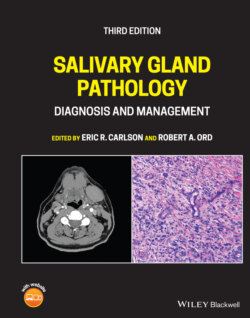Читать книгу Salivary Gland Pathology - Группа авторов - Страница 25
Retromandibular Vein
ОглавлениеThe vein is formed within the parotid gland by the union of the superficial temporal vein and the maxillary vein. The retromandibular vein passes downwards and close to the lower pole of the parotid where it often divides into two branches passing out of the gland. The posterior branch passes backward to unite with the posterior auricular vein on the surface of the sternocleidomastoid muscle to form the external jugular vein. The anterior branch passes forward to join the facial vein.
The retromandibular vein is an important landmark during parotid gland surgery. The division of the facial nerve into its temporofacial and cervicofacial divisions occurs just behind the retromandibular vein (Figure 1.7). The two divisions lie just superficial to the vein in contact with it. It is all too easy to tear the vein while exposing the division of the facial nerve!
Figure 1.6. The branching patterns of the facial nerve.
Source: Berkovitz et al. 2003/Taylor & Francis.
| I Type I, 13% | V Type V, 9% | 3 Buccal branch |
| II Type II, 20% | VI Type VI, 6% | 4 Mandibular branch |
| III Type III, 28% | Temporal branch | 5 Cervical branch |
| IV Type IV, 24% | 2 Zygomatic branch |
Figure 1.7. The facial nerve and its relationship to the retromandibular vein within the parotid gland.
Source: Published with permission, Martin Dunitz, London, Langdon JD, Berkowitz BKB, Moxham BJ, editors, Surgical Anatomy of the Infratemporal Fossa. DOI: 10.1002/9781118949139.ch1.
1 Facial nerve at stylomastoid foramen
2 Temporofacial branch of facial nerve
3 Cervicofacial branch of facial nerve
4 Temporal branch of facial nerve
5 Zygomatic branch of facial nerve
6 Buccal branch of facial nerve
7 Mandibular branch of facial nerve
8 Cervical branch of facial nerve
9 Posterior belly of the digastric muscle
10 Retromandibular vein and external carotid artery
